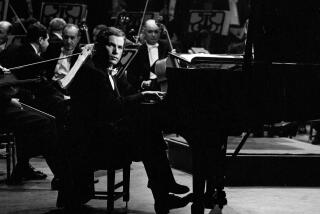Revolutionary hits half-century mark
- Share via
SAN FRANCISCO — In the years after he wrote “Howl,” Allen Ginsberg alternately described the poem as a song of spiritual liberation, a homage to art, an ode to gay love and a lament for his mentally ill mother.
The Beat poet who defined his times with the salvo “I saw the best minds of my generation destroyed by madness,” gave perhaps the most adroit explanation, however, upon publication of the original facsimile edition of the tour de force that had launched his career more than three decades earlier.
“Howl,” he advised readers in his preface, was meant to be an “emotional time bomb that would continue exploding.”
With nearly 1 million copies in print, it is one of the most widely read poems of the 20th century.
Still, critics disagree about the place Ginsberg’s best-known work holds in American letters. But even its detractors acknowledge that his provocative assault on the Cold War and conformity roared across the cultural landscape in a way that continues to resonate half a century after its storied debut at a San Francisco art gallery.
Ginsberg first publicly read “Howl” as a work-in-progress on Oct. 7, 1955 -- 50 years ago Friday -- a date that holds as much meaning for followers of the Beats as “Bloomsday,” June 16, does for fans of James Joyce’s “Ulysses.” The Six Gallery reading, as it has since become known, preceded by a year the poem’s publication and the moral outrage provoked by its defense of homosexuality and drug use.
The wine-soaked gathering also featured poets Gary Snyder, Michael McClure, Phil Lamantia and Phil Whalen and was hosted by elder statesman Kenneth Rexroth. Admirers regard it as a turning point that took poetry out of the ivory tower -- creating space for dissent and presaging the youthful rebellion that inspired folk music, sexually explicit performance art and more recently, poetry slams.
While “Howl and Other Poems” was being prepared for publication, Ginsberg and other Beat poets took their show on the road, performing up and down the West Coast. It wasn’t until spring 1957, after San Francisco police arrested San Francisco’s City Lights bookstore owner Lawrence Ferlinghetti and store manager Shigeyoshi Murao on charges of selling obscene material, that the book became a symbol of the social tensions Ginsberg sought to expose.
With help from the American Civil Liberties Union, they were acquitted, and the judge’s ruling established a legal standard for publishing controversial books of “redeeming social importance.”
Members of the Academy of American Poets still debate whether “Howl” has had legs only because of its early notoriety, but there is no denying its “profound influence on the course of American poetry,” said Tree Swenson, the academy’s executive director. “If the words were not compelling, if they did not have the kind of power that they have, this would not have happened. If it had been plain bad writing, no one would have bothered.”
City Lights will publish a fully annotated Golden Anniversary edition of “Howl and Other Poems” next year. Farrar Straus & Giroux is preparing a collection of essays by writers such as Andrei Codrescu, Vivian Gornick, Phillip Lopate, Daphne Merkin, Rick Moody and Robert Pinsky called “The Poem That Changed America.” A feature-length documentary, “Howl: The Movie,” is also in the works.
More to Read
Sign up for our Book Club newsletter
Get the latest news, events and more from the Los Angeles Times Book Club, and help us get L.A. reading and talking.
You may occasionally receive promotional content from the Los Angeles Times.










